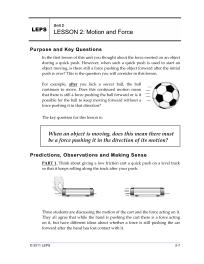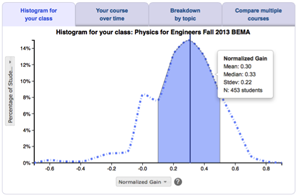
Learning Physical Science
Developed by: Fred Goldberg, Stephen Robinson, Edward Price, Rebecca Kruse, Danielle Boyd Harlow and Michael McKean
Level










middle schoolhigh schoolintro collegeinter-mediateupper levelgrad school other

conceptual



middle schoolhigh schoolintro collegeinter-mediateupper levelgrad school other

conceptual
Topics






Setting




Overview
What? A guided-inquiry, conceptual physical science course intended for teaching in a lecture-style environment, e.g. classes with large enrollment. Helps students develop a deep understanding of main ideas from physical science as well as the nature of science and the nature of learning.
Topic outline
- Unit 1: Interactions and Energy introduces students to all of the common themes of the course, in particular the themes of interactions between objects and the energy description of interactions.
- Unit 2: Interactions and Forces introduces students to an alternative framework (that of forces) within which they can explain interactions they first see in Unit 1 that involve objects pushing or pulling on one another.
- Unit 3: Interactions and Potential Energy introduces students to the ideas of "fields of influence" mediating interactions that can occur over a distance, specifically the magnetic, electric charge and gravitational interactions. The concept of potential energy is also introduced.
- Unit 4: Small Particle Theory of Gases introduces the scientists' Small Particle Theory (SPT) of matter and applies it to phenomena involving gases, making use of computer simulators that model the behavior of gases on both macroscopic and microscopic scales.
- Unit 5: Small Particle Theory of Liquids and Solids focuses on physical properties and changes in the context of liquids and solids. Students investigate physical changes at both the macroscopic and microscopic (small particle) scales.
- Unit 6: Interactions and Chemistry focuses on chemical changes and their particle-level underpinnings, employing both demonstrations (via video) and simulators that model chemical reactions and decomposition on both the macroscopic and microscopic scales.
Student skills developed
Designed for:
- Conceptual understanding
Can be adapted for:
- Making real-world connections
Instructor effort required
- Low
Resources required
- Clickers / polling method
- Projector
- Computers for students
- Cost for students
Resources
Developer's website: Learning Physical Science
Intro Article: F. Goldberg, E. Price, S. Robinson, D. Boyd-Harlow, and M. McKean, Developing the learning physical science curriculum: Adapting a small enrollment, laboratory and discussion based physical science course for large enrollments, Phys. Rev. ST Phys. Educ. Res. 8 (1), 010121 (2012).
Teaching Materials
You can order the LEPS materials from their publisher, Activate Learning. You can download a sample activity from PhysPort.
Research
RESEARCH VALIDATION
This is the third highest level of research validation, corresponding to:
- at least 1 of the "based on" categories
- at least 1 of the "demonstrated to improve" categories
- at least 1 of the "studied using" categories
Research Validation Summary
Based on Research Into:
- theories of how students learn
- student ideas about specific topics
Demonstrated to Improve:
- conceptual understanding
- problem-solving skills
- lab skills
- beliefs and attitudes
- attendance
- retention of students
- success of underrepresented groups
- performance in subsequent classes
Studied using:
- cycle of research and redevelopment
- student interviews
- classroom observations
- analysis of written work
- research at multiple institutions
- research by multiple groups
- peer-reviewed publication
References
- F. Goldberg, E. Price, D. Harlow, S. Robinson, R. Kruse, and M. McKean, Development and evaluation of large-enrollment, active-learning physical science curriculum, presented at the Physics Education Research Conference 2010, Portland, Oregon, 2010.
- F. Goldberg, E. Price, S. Robinson, D. Boyd-Harlow, and M. McKean, Developing the learning physical science curriculum: Adapting a small enrollment, laboratory and discussion based physical science course for large enrollments, Phys. Rev. ST Phys. Educ. Res. 8 (1), 010121 (2012).
- D. Harlow, V. Otero, A. Leak, S. Robinson, E. Price, and F. Goldberg, Learning about teaching and learning while learning physics: An analysis of 15 years of responsive curriculum development, Phys. Rev. Phys. Educ. Res. 16 (2), 020155 (2020).
- D. Harlow, L. Swanson, H. Dwyer, and J. Bianchini, Learning Pedagogy in Physics, presented at the Physics Education Research Conference 2010, Portland, Oregon, 2010.





